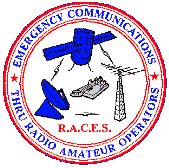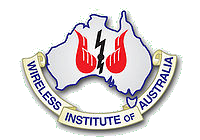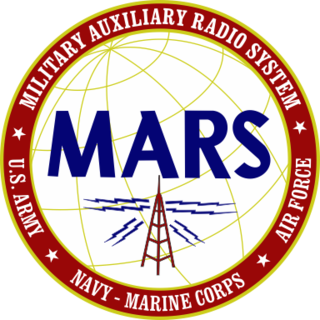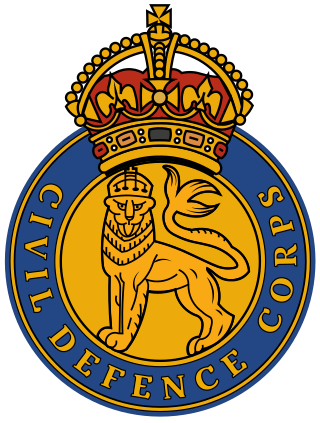Automatic Link Establishment, commonly known as ALE, is the worldwide de facto standard for digitally initiating and sustaining HF radio communications. ALE is a feature in an HF communications radio transceiver system that enables the radio station to make contact, or initiate a circuit, between itself and another HF radio station or network of stations. The purpose is to provide a reliable rapid method of calling and connecting during constantly changing HF ionospheric propagation, reception interference, and shared spectrum use of busy or congested HF channels.

The Q-code is a standardised collection of three-letter codes that each start with the letter "Q". It is an operating signal initially developed for commercial radiotelegraph communication and later adopted by other radio services, especially amateur radio. To distinguish the use of a Q-code transmitted as a question from the same Q-code transmitted as a statement, operators either prefixed it with the military network question marker "INT" or suffixed it with the standard Morse question mark UD.

Skywarn is a program of the National Weather Service (NWS). Its mission is to collect reports of localized severe weather in the United States. These reports are used to aid forecasters in issuing and verifying severe weather watches and warnings and to improve the forecasting and warning processes and the tools used to collect meteorological data. Reports are also used by local emergency managers and public safety organizations.
Citizens band radio is a system of short-distance radio communications between individuals on a selection of 40 channels within the 27-MHz band. In the United Kingdom, CB radio was first legally introduced in 1981, but had been used illegally for some years prior to that.

A radiotelephone, abbreviated RT, is a radio communication system for conducting a conversation; radiotelephony means telephony by radio. It is in contrast to radiotelegraphy, which is radio transmission of telegrams (messages), or television, transmission of moving pictures and sound. The term is related to radio broadcasting, which transmit audio one way to listeners. Radiotelephony refers specifically to two-way radio systems for bidirectional person-to-person voice communication between separated users, such as CB radio or marine radio. In spite of the name, radiotelephony systems are not necessarily connected to or have anything to do with the telephone network, and in some radio services, including GMRS, interconnection is prohibited.

In the United States and Canada, the Amateur Radio Emergency Service (ARES) is a corps of trained amateur radio operator volunteers organized to assist in public service and emergency communications. It is organized and sponsored by the American Radio Relay League and the Radio Amateurs of Canada.

The Radio Amateur Civil Emergency Service (RACES) is an emergency radio service authorized in Part 97.407 of the Federal Communications Commission (FCC) rules and regulations governing amateur radio in the United States.

The Wireless Institute of Australia (WIA) was formed in 1910, and is the first and oldest national amateur radio society in the world. It represents the amateur radio operators of Australia as the AR "peak body" in dealings with the Australian Communications and Media Authority (ACMA), the authority under the government of Australia that administers communications within and external to Australia. The WIA publishes a bi-monthly journal for its membership called Amateur Radio. The organisation is the national society representing Australia in the International Amateur Radio Union. The WIA holds regular meetings with the ACMA to inform the Authority on matters concerning the Australian amateur radio community.
The annual Simulated Emergency Test (SET) is a training exercise involving the Amateur Radio Emergency Service (ARES) and the National Traffic System (NTS), a message-handling service of amateur radio. The American Radio Relay League is a prime mover in this event, which is organized somewhat like a contest. Its primary purposes are to evaluate strengths and weaknesses in emergency preparedness and communications, and to demonstrate amateur radio to the public.

The Military Auxiliary Radio System (MARS) is a United States Department of Defense sponsored program, established as a separately managed and operated program by the United States Army and the United States Air Force. The United States Navy-Marine Corps program closed in 2015. The program is a civilian auxiliary consisting primarily of licensed amateur radio operators who are interested in assisting the military with communications on a regional and national level when access to traditional forms of communication may no longer be available. The MARS programs also include active duty, reserve, and National Guard units; and Navy, Marine Corps units.
The Salvation Army Team Emergency Radio Network (SATERN) is a network of volunteer amateur radio operators based in North America. It works to provide emergency communications between Salvation Army posts during times of disaster, and to pass messages with health and welfare information between the Salvation Army and the general public.

In times of crisis and natural disasters, amateur radio is often used as a means of emergency communication when wireline, cell phones and other conventional means of communications fail.
The New Zealand Association of Radio Transmitters (NZART) is a non-profit organisation of amateur radio enthusiasts in New Zealand. It represents New Zealand amateur radio operators nationally and internationally. NZART is a founding member of the International Amateur Radio Union. It is an association of individual members, however those members are encouraged to form local branches.

Amateur Radio Emergency Communications (AREC), formerly the Amateur Radio Emergency Corps, is a service provided by the New Zealand Association of Radio Transmitters (NZART) which provides trained radio communicators and communication systems for emergency situations.

The Mumbai Amateur Radio Society or MARS is an amateur radio club based in Mumbai, India. The club was founded on 7 August 2000 by a group of 25 active hams. Since then it has grown to over two hundred members and is the largest such club in the metropolis. MARS is a registered 80G tax-deductible non-profit organization.
Amateur radio or ham radio is practised by more than 22,000 licensed users in India. The first amateur radio operator was licensed in 1921, and by the mid-1930s, there were around 20 amateur radio operators in India. Amateur radio operators played an important part in the Indian independence movement with the establishment of illegal pro-independence radio stations in the 1940s. The three decades after India's independence saw only slow growth in the number of operators until the then Prime Minister of India and amateur radio operator, Rajiv Gandhi (VU2RG), waived the import duty on wireless equipment in 1984. Since then, numbers have picked up, and as of 2007, there were more than 16,000 operators in the country. Amateur radio operators have played a vital role during disasters and national emergencies such as earthquakes, tsunamis, cyclones, floods, and bomb blasts, by providing voluntary emergency communications in the affected areas.

The Civil Defence Corps (CDC) was a civilian volunteer organisation established in Great Britain in 1949 to mobilise and take local control of the affected area in the aftermath of a major national emergency, principally envisaged as being a Cold War nuclear attack. By March 1956, the Civil Defence Corps had 330,000 personnel. It was stood down in Great Britain in 1968, although two Civil Defence Corps still operate within the British Isles, namely the Isle of Man Civil Defence Corps and the unrelated Civil Defence Ireland in the Republic of Ireland. Many other countries maintain a national Civil Defence Corps, usually having a wide brief for assisting in large scale civil emergencies such as flood, earthquake, invasion, or civil disorder.

Amateur radio, also known as ham radio, is the use of the radio frequency spectrum for purposes of non-commercial exchange of messages, wireless experimentation, self-training, private recreation, radiosport, contesting, and emergency communications. The term "amateur" is used to specify "a duly authorized person interested in radioelectric practice with a purely personal aim and without pecuniary interest" ; and to differentiate it from commercial broadcasting, public safety, or professional two-way radio services.
An emergency communication system (ECS) is any system that is organized for the primary purpose of supporting one-way and two-way communication of emergency information between both individuals and groups of individuals. These systems are commonly designed to convey information over multiple types of devices, from signal lights to text messaging to live, streaming video, forming a unified communication system intended to optimize communications during emergencies. Contrary to emergency notification systems, which generally deliver emergency information in one direction, emergency communication systems are typically capable of both initiating and receiving information between multiple parties. These systems are often made up of both input devices, sensors, and output/communication devices. Therefore, the origination of information can occur from a variety of sources and locations, from which the system will disseminate that information to one or more target audiences.
The Wireless Institute Civil Emergency Network (WICEN) is a group of Australian emergency amateur radio organisations. WICEN groups provide communications during emergencies or disasters when normal communications stop working. WICEN groups have assisted during bushfires, floods and cyclones. WICEN groups also provide communications at events such as the Great Victorian Bike Ride, Red Cross Hawkesbury River Canoe Marathon and National Capital Rally. WICEN groups meet regularly to train and conduct exercises with other agencies.












